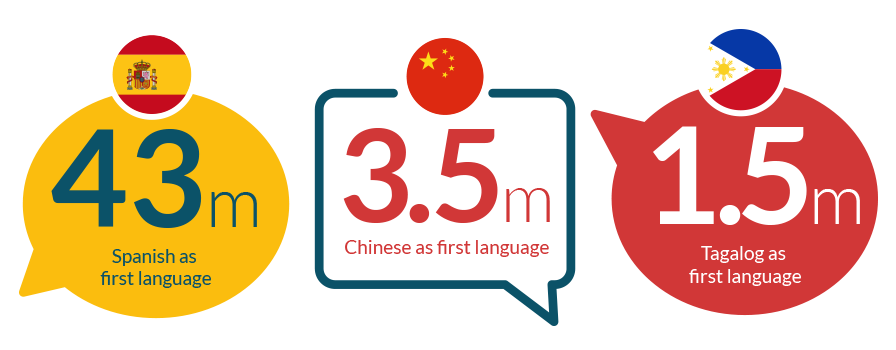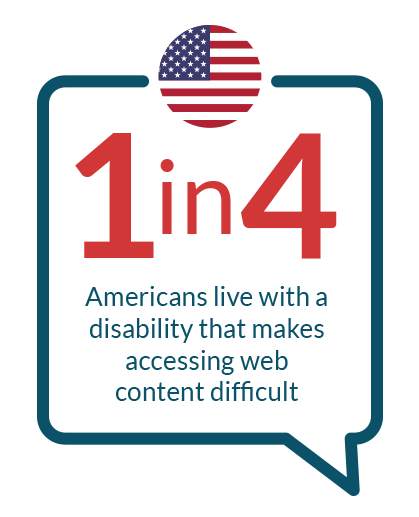On a national level, the United States is home to an incredibly diverse range of languages. So if your website is not able to be translated on screen or read aloud in the reader’s language of preference, you could be missing out on a serious percentage of your target market.
Languages Trends in America
The dominant language spoken across America is English, but several other languages are spoken by millions of residents.
Data USA statistics show that:
- 44.8 million people (13.7% of the population) were born in another country.
Over 67million (20% of the population) speak a language other than English at home.
It will come as little surprise that outside of English, the most frequently spoken language is Spanish. The population of America stands at over 332 million in 2021, and more than 43 million (around 13%) speak Spanish as a first language.
The next most frequently spoken languages equate to a further 3% of the population:
Chinese (including Cantonese and Mandarin) – over 3.5 million speakers.
Tagalog (including Filipino) – over 1.5 million speakers.
Vietnamese – over 1 million speakers.
Arabic – over 1 million speakers.
French – over 1 million speakers.
Korean – over 1 million speakers.

The Impacts of Language on National and International Organizations
Having over 16% of the total population speak a language other than English creates a problem for marketers. Businesses would be unwise to discount the spending power of 53 million people, so websites need to be accommodating a range of linguistic preferences. In a recent annual report, the Selig Center for Economic Growth at the University of Georgia estimated that the spending power of America’s Hispanic population alone is over $1.5 trillion per year.
For businesses operating internationally, it’s also worth noting that 47% of internet users globally are non-English speaking, a statistic that makes website accessibility in multiple languages an even higher priority.
Public sector bodies and not-for-profit organizations also need to accommodate varying linguistic needs on their websites. The many and varied language preferences of Americans mean a significant proportion of residents need language support to access public services like education, healthcare, transport, etc.
The Impacts of Language on Small Businesses
If you have a small or more regional online business, you may be thinking that having options for multiple language preferences on your website is not an important consideration. However, it’s not something you should dismiss just yet, as every state in the US has more complex language variances than you may think.
According to the Bureau of Economic Analysis, the seven most populous states in the country are also the biggest contributors to U.S. GDP, and all are home to a variety of language preferences.
California – 12% of all Americans live in California, and 44.6% of residents speak English as a second language. The most frequently spoken languages after English and Spanish are Chinese and Tagalog.
Texas – 9% of all Americans live in Texas, and 35.8% of residents speak English as a second language. The most frequently spoken languages after English and Spanish are Vietnamese and Chinese.
Florida – 6.5% of all Americans live in Florida, and 29.7% of residents speak English as a second language. The most frequently spoken languages after English and Spanish are Haitian and Portuguese.
New York – New York City is the biggest metropolitan area in the country, and as such boasts the largest number of languages. 6% of all Americans live in New York State, and 30.7% of residents speak English as a second language. The most frequently spoken languages after English and Spanish are Chinese and Russian.
Illinois – 4% of all Americans live in Illinois and 23.5% of residents speak English as a second language. The most frequently spoken languages after English and Spanish are Polish and Chinese.
Ohio – 3.5% of all Americans live in Ohio and 7.34% of residents speak English as a second language. The most frequently spoken languages after English and Spanish are Yiddish and Chinese.
Pennsylvania – 3% of all Americans live in Pennsylvania and 11.9% of residents speak English as a second language. The most frequently spoken languages after English and Spanish are Chinese and Yiddish.
Using Assistive Technology to Be Inclusive
Using assistive technology like the Recite Me toolbar is an easy and cost-effective way to include customers who don’t speak English as a first language.
Translating websites into multiple different language formats, without the use of accessibility translation toolbars, is both time-consuming and costly. Budget restraints often limit the number of languages you can choose, and some languages like Arabic and Hebrew are complicated to code and involve significant changes to the layout and graphics so that each page can be read from right to left.
Recite Me can usually be installed on your website in under an hour with just a few lines of JavaScript, and instantly provides your website visitors with access to:
Text translation in over 100 languages
Text-to-speech in 65 languages
A built-in dictionary and thesaurus to check definitions
The Business Benefits
Profitability will naturally increase once your website becomes accessible to more people. Research by Net Media Planet confirmed a 20% increase in conversions when landing pages and ads were translated, and up to a 70% increase on websites that translated their entire site.
It’s not just about the bottom line though. There are many other benefits to being inclusive of multiple language needs, including:
Improved SEO results – With more people visiting and browsing your site, your search engine rankings will improve. Learn more about the benefit of SEO and Web Accessibility here.
New markets – Tap into new customer markets you couldn’t access – or access easily – before.
A stronger brand – More site visitors and sales conversions mean more awareness of your brand in general. Plus, customers favor value-driven brands, so you can further improve your brand reputation by being inclusive of varying linguistic needs.
“When your site is available in multiple languages, you attract the attention of an international market. You also become identified as a global brand which elevates your status and improves your reputation. Consumers tend to trust global brands more than ones that are only known locally.”
Nick McGuire, E-commerce specialist and blogger
What the Data Says
We work with companies across multiple sectors including e-commerce, finance, construction, education, recruitment, technology, sport, transport, public sector, charities, and non-profits.
In the last 12 months in America, our stats showed that:
294,919 pages of content were viewed using the Recite Me toolbar
The top 3 languages for on-page translation were Spanish, French, and Chinese.
Over 158,000 pieces of content were translated into Spanish
Over 12,000 pieces of content were translated into Chinese
The top 3 languages for screen reader playback were English, Spanish and French.
Nearly 20,000 pieces of content were read aloud in Spanish.

We’re Much More Than a Translation Service
Recite Me doesn’t only help boost your business with translation services. Our accessibility toolbar is designed to make the journey through your website more inclusive to anyone who encounters access barriers. This goes way further than language preferences and also includes those with vision deficits, learning difficulties, cognitive and neurological difficulties, and physical disabilities.
 1 in every 4 Americans is estimated to be living with a disability that makes accessing web content difficult. So using Recite me provides an all-in-one solution to breaking down language barriers and opens your business up to a much wider market at the same time.
1 in every 4 Americans is estimated to be living with a disability that makes accessing web content difficult. So using Recite me provides an all-in-one solution to breaking down language barriers and opens your business up to a much wider market at the same time.
Comprising several accessibility features that can be used individually or combined, users can completely customize the way they read your web content by:
Personalizing font size, type, and color options to make each web page easier to read.
Utilizing the mask screen tool, which isolates parts of the page to help with focus.
Using the ruler tool to make reading easier.
Downloading content as an audio file as an alternative to reading.
What Our Clients Say
At Recite Me we pride ourselves on our exceptional service, the power of our software, and the benefits it brings to our clients and the end-users of their websites. Here are some examples of feedback we’ve been given.
“We have a long history of innovative solutions to spearhead its focus on customer service. Recite Me is a cost-effective solution for delivering web content in foreign languages and also adds so many more accessibility tools to improve the user experience for visitors to our site “
Jerry Harris, Assistant Director of Marketing & Air Service Development, Orlando International Airport
Orlando Airport is just one example of an airport website using accessibility tools. Many travel and transport companies use Recite Me, as these are the markets that most commonly need to accommodate multiple language preferences. However, the benefits extend to any organization that can reach a wider audience by making its website more inclusive to those who face access barriers. This includes leisure and entertainment venues, finance companies, law firms, and marketing agencies.
” Recite Me allows us to ensure an inclusive online environment and positive user experience for all of our partners and employees. We couldn’t be more thrilled to provide this tool for their website usage. “
Alexandra Forsch, President of Awin US
Check out our main web pages for more testimonials and information on the different industry sectors that we serve.
Our 40-page Digital Accessibility & Inclusion Toolkit helps businesses break down online barriers and make a real impact. It offers practical advice on all aspects of digital accessibility, from writing an accessibility statement to accessible website tips and inclusive hiring.

Does Your Website Speak Your Customers’ Language?
No? Then now is the time to make some changes, become a more inclusive business, and reap the rewards of reaching a much wider market.
Contact our team or book a live demonstration today, and join the thousands of organizations that are already enjoying the benefits of having a more inclusive website.
Be sure to try out our website accessibility checker online for free today.


